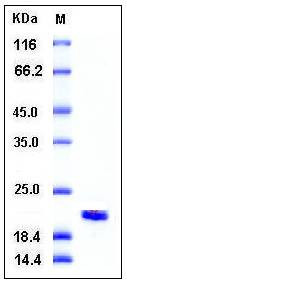Human NME1 / NDKA Protein (His Tag)
AWD,GAAD,NB,NBS,NDKA,NDPK-A,NDPKA,NM23,NM23-H1
- 100ug (NPP4119) Please inquiry
| Catalog Number | P11615-H07E |
|---|---|
| Organism Species | Human |
| Host | E. coli |
| Synonyms | AWD,GAAD,NB,NBS,NDKA,NDPK-A,NDPKA,NM23,NM23-H1 |
| Molecular Weight | The recombinant human NME1 consisting of 158 amino acids and has a calculated molecular mass of 18 kDa. It migrates as an approximately 21 kDa band in SDS-PAGE under reducing conditions. |
| predicted N | Met |
| SDS-PAGE |  |
| Purity | > 98 % as determined by SDS-PAGE |
| Protein Construction | A DNA sequence encoding the human NME1 isoform b (NP_000260.1) (Ala 2-Glu 152) was expressed, with a polyhistide tag at the N-terminus. |
| Bio-activity | Kinase activity untested |
| Research Area | Cancer |Cell cycle |Cell Cycle Checkpoint |
| Formulation | Supplied as sterile PBS, pH 7.4 1. Normally 5 % - 8 % trehalose and mannitol are added as protectants before lyophilization. Specific concentrations are included in the hardcopy of COA. |
| Background | NME1, also known as Nucleoside Diphosphate Kinase A (NDK-A), or NM23-H1, belongs to the NDK family. NM23-H1 is known to have a metastasis suppressive activity in many tumor cells. Recent studies have shown that the interacting proteins with NM23-H1 which mediate the cell proliferation, may act as modulators of the metastasis suppressor activity. The interacting proteins with NM23-H1 can be classified into 3 groups. The first group of proteins can be classified as upstream kinases of NM23-H1 such as CKI and Aurora-A/STK15. The second group of proteins acts as downstream effectors for the regulation of specific gene transcriptions, GTP-binding protein functions, and signal transduction in Erk signal cascade. The third group of proteins can be classified as bi-directionally influencing binding partners of NM23-H1. As a result, the interactions with NM23-H1 and binding partners have implications in the biochemical characterization involved in metastasis and tumorigenesis. NDKA is increased in human postmortem cerebrospinal fluid (CSF), a model of global brain insult, suggesting that measurement in CSF and, more importantly, in plasma may be useful as a biomarker of stroke. Additionally, NM23-H1 significantly reduces metastasis without effects on primary tumor size and was the first discovered metastasis suppressor gene. |
| Reference |
